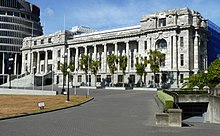| 52nd Parliament of New Zealand | |||||
|---|---|---|---|---|---|
| |||||
 | |||||
| Overview | |||||
| Legislative body | New Zealand Parliament | ||||
| Term | 7 November 2017 – 6 September 2020[1] | ||||
| Election | 2017 New Zealand general election | ||||
| Government | Sixth Labour Government | ||||
| House of Representatives | |||||
 | |||||
| Members | 120 | ||||
| Speaker of the House | Trevor Mallard | ||||
| Leader of the House | Chris Hipkins | ||||
| Prime Minister | Jacinda Ardern | ||||
| Leader of the Opposition |
| ||||
| Sovereign | |||||
| Monarch | Elizabeth II | ||||
| Governor-General | Patsy Reddy | ||||
The 52nd New Zealand Parliament was a meeting of the legislature in New Zealand, which opened on 7 November 2017 following the 2017 general election and dissolved on 6 September 2020. The New Zealand Parliament comprises the Sovereign (represented by the governor-general) and the House of Representatives, which consists of 120 members.[2]
The 52nd Parliament was elected using a mixed-member proportional representation (MMP) voting system. Members of Parliament (MPs) represent 71 geographical electorates: 16 in the South Island, 48 in the North Island and 7 Māori electorates. The remaining members were elected from party lists using the Sainte-Laguë method to achieve proportionality. The number of geographical electorates was increased by one at the 2014 election, to account for the North Island's higher population growth.[3]
- ^ Cite error: The named reference
election delayedwas invoked but never defined (see the help page). - ^ "Our system of government". Electoral Commission (New Zealand). Archived from the original on 29 February 2000. Retrieved 24 September 2017.
- ^ "Reviewing electorate numbers and boundaries". Elections New Zealand. Archived from the original on 9 November 2011. Retrieved 6 January 2012.
